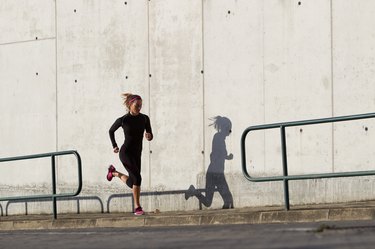
Tidal volume is the volume of air you breathe in a single breath. Exercise causes an increase in tidal volume because your requirements for oxygen go up. This increase is mediated in different ways depending on when it occurs during your exercise. An increase in tidal volume is necessary to effectively meet your body's increased oxygen requirements, as an increase in your rate of respiration alone is not sufficient.
Read more: Causes of Chest Tightness and Cough
Video of the Day
Video of the Day
What is Tidal Volume
According to Duke University, in a normal male adult, tidal volume is approximately 500 ml of air per breath. For women, the amount is 20 to 25 percent less than that. However, changes in air requirements, such as those that occur during exercise, and changes in your lungs' ability to expand and contract, such as those that occur with certain neuromuscular and respiratory diseases, can change tidal volume.
Increased Tidal Volume During Exercise
Your lungs' job is to meet your body's demand for oxygen, which is required for the cells in your body to produce enough energy to function. Your lungs do this by bringing in fresh air with every breath; this amount is measured in part by the tidal volume. During exercise, your body's production of carbon dioxide goes up. Increasing tidal volume during exercise is one way for your lungs to accommodate the exhalation of this increased carbon dioxide load.
Tidal Volume: Early Increase
According to Kim Barrett and colleagues in their "Ganong's Review of Medical Physiology," the drivers of increased tidal volume, and to a lesser extent of increased breathing rate which also helps your lungs to exhale carbon dioxide, are divided into those that function immediately upon beginning exercise, and those that function after you've been exercising for a while. Immediate increases are likely mediated by reflexes involving your brainstem and motor cortex, in what is likely a reflex loop between these structures and your respiratory muscles.
Tidal Volume: Later Increase
Later increases in tidal volume are likely mediated by chemical receptors in your circulation which recognize that your body's metabolism has increased, and respond by instructing your lungs to emit more carbon dioxide. The chemicals involved in this increase include oxygen, carbon dioxide, lactic acid, arachadonic acid and bradykinin, and the receptors involved are located on many organs throughout your body.
Read more: How to Improve Lung Capacity for Running
Consider the "Dead Space"
Your lungs are made up of tissues that can exchange carbon dioxide for oxygen, and also of tissues that cannot. The air included in a tidal volume measurement interacts with both of these parts — so it follows that not all of the air in the tidal volume is exchanging carbon dioxide for oxygen. The component of your tidal volume that is not involved in carbon dioxide/oxygen exchange is known as the "dead space," according to StatPearls.
In order to move more air into your lungs during exercise, you have two options: increase the rate at which you're breathing, or increase your tidal volume. Increasing only the rate will increase the proportion of air that you breathe that belongs to the dead space volume; hence, an increase in tidal volume is necessary to facilitate effective gas exchange.